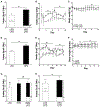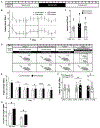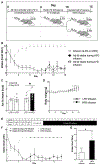Post-oral sensing of fat increases food intake and attenuates body weight defense
- PMID: 34686319
- PMCID: PMC8609494
- DOI: 10.1016/j.celrep.2021.109845
Post-oral sensing of fat increases food intake and attenuates body weight defense
Abstract
In mammals, changes in weight elicit responses that favor a return to one's previous weight and promote weight stability. It has been hypothesized that palatable sweet and high-fat foods disturb the defense of body weight, leading to weight gain. We find that increasing sweetness or percent calories from fat increases diet palatability but that only increases in nutritive fat content increase caloric intake and body weight. In a mouse model of overfeeding that activates weight defense, high-fat diets, but not sweetened diets, attenuate the defense of body weight, leading to weight gain. The ability of a palatable, high-fat diet to increase food intake does not require tasting or smelling the food. Instead, the direct infusion of a high-fat diet into the stomach increases the ad libitum intake of less palatable, low-fat food. Post-oral sensing of percent calories from fat modulates feeding behavior to alter weight stability.
Keywords: body weight defense; gastric infusion; high-fat diet; palatability; post-oral sensing; sweetened diet.
Copyright © 2021 The Authors. Published by Elsevier Inc. All rights reserved.
Conflict of interest statement
Declaration of interests A.W.F. is supported by a research grant from Boehringer-Ingelheim Pharmaceuticals. The authors declare no other competing interests.
Figures






References
Publication types
MeSH terms
Substances
Grants and funding
LinkOut - more resources
Full Text Sources
Medical

